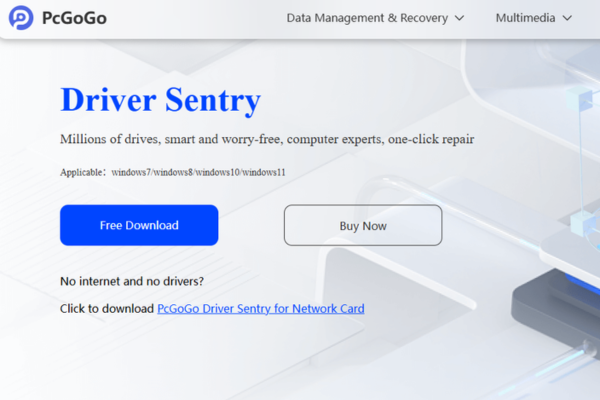Are you tired of experiencing choppy gameplay, laggy video playback, or a generally subpar visual experience on your computer? One of the most effective ways to boost your system's graphics performance is to update graphics card driver. In this comprehensive guide, we'll walk you through how to update graphics card driver, and we'll also introduce you to a handy tool that can simplify the process.

Why Do You Update Graphics Card Driver?
Updating graphics card driver is crucial for several reasons. First and foremost, new driver versions often come with performance improvements. Whether you're a gamer who wants smoother frame rates during intense battles or a video editor who needs faster rendering times, an updated graphics driver can make a significant difference. For example, if you've noticed that your favorite game is stuttering or that videos are pixelated, updating graphics driver might just be the solution.
Secondly, driver updates can fix bugs and compatibility issues. Sometimes, after installing a new game or software, you might encounter graphical glitches or crashes. This could be due to an outdated graphics driver that's not fully compatible with the new application. By updating the driver, you ensure that your graphics card can work harmoniously with the latest software releases.
Moreover, manufacturers frequently release driver updates to enhance the stability of your graphics card. A more stable driver means fewer unexpected freezes or system crashes, which can be a real headache, especially when you're in the middle of an important task or an exciting gaming session.
How to Update Graphics Card Driver?
Identify Your Graphics Card Model
Before you can update graphics card driver, you need to know which model you have. This is a crucial first step to update graphics card driver. On Windows, you can right-click on the "This PC" icon on your desktop and select "Properties". Then, click on "Device Manager" in the left-hand menu. In the Device Manager window, expand the "Display adapters" category. Here, you'll see the name of your graphics card. For example, it could be an NVIDIA GeForce GTX 1660 or an AMD Radeon RX 5700 XT.
Visit the Manufacturer's Website
Once you've identified your graphics card model, the next step is to visit the official website of the manufacturer. If you have an NVIDIA graphics card, head over to the NVIDIA website. If it's an AMD card, go to the AMD website. On the manufacturer's website, look for a "Support" or "Downloads" section. Here, you'll usually be prompted to enter your graphics card model and your operating system details. Make sure to select the correct operating system version, whether it's Windows 10, Windows 11, or something else. After entering the required information, the website will display the latest available graphics card driver for your specific model. Click on the download link to start the download. The file will usually be in an executable format. Save it to a location on your computer that you can easily access, like your desktop.

Install the Downloaded Driver
After the driver download is complete, locate the file on your desktop or wherever you saved it. Double-click on the executable file to start the installation process. Follow the on-screen instructions. The installer will usually ask you to accept the license agreement and might give you the option to choose the installation location. In most cases, you can just go with the default settings. Once the installation is finished, you'll likely be prompted to restart your computer. This is an important step as it allows the new driver to take effect properly.
PcGoGo Driver Sentry
While the manual method of updating graphics driver works, it can be time-consuming and a bit complicated, especially if you're not very tech-savvy. This is where PcGoGo Driver Sentry comes in handy.
PcGoGo Driver Sentry is a powerful tool that simplifies the entire driver update process. With just a few clicks, it can scan your computer to identify all the outdated drivers, including your graphics card driver. To use it, first, download PcGoGo Driver Sentry from the PcGoGo website. Once installed, open the software. You'll see a prominent "Scan" button. Click on it, and Driver Sentry will start analyzing your system.
In no time, it will present you with a list of all the drivers that need updating, clearly indicating the graphics card driver among them. You don't have to worry about searching for the correct driver on the manufacturer's website or making sure you've selected the right version for your operating system. PcGoGo Driver Sentry takes care of all that. Simply click on the "Update" button next to the graphics card driver entry, and the tool will automatically download and install the latest and most compatible version for you. After the update is complete, it will prompt you to restart your computer, just like the manual installation process. Using PcGoGo Driver Sentry not only saves you time but also reduces the risk of making mistakes during the driver update process.

Updating Graphics Driver: Potential Issues and Solutions
Compatibility Issues
Sometimes, even when you update graphics card driver, you might encounter compatibility issues. For example, the new driver might not work well with some of your older software or games. If this happens, you can try rolling back to the previous driver version. In the Device Manager, right-click on your graphics card and select "Properties". In the Properties window, go to the "Driver" tab and click on "Roll Back Driver". This will revert your graphics card to the previous driver version, hopefully resolving any compatibility issues.
Installation Errors
Installation errors can also occur during the "updating graphics driver" process. This could be due to a corrupted download or interference from other software on your computer. If you suspect a corrupted download, try downloading the driver again from the manufacturer's website or using PcGoGo Driver Sentry. If the problem persists, you might need to temporarily disable any antivirus or security software that could be blocking the installation. However, be sure to re-enable your security software once the installation is complete to keep your computer safe.
Conclusion
Updating graphics driver is an essential task for anyone who wants to get the best out of their computer's graphics capabilities. Whether you choose to update graphics card driver manually or use a tool like PcGoGo Driver Sentry, the key is to ensure that you have the latest and most compatible driver installed. By following the steps outlined in this guide, you can easily overcome any obstacles and enjoy a smoother, more visually appealing computing experience. So, don't let an outdated graphics card driver hold you back. Take the time to update it today, and you'll notice a significant difference in how your games look, how videos play, and how smoothly your overall system runs. And if you ever run into any issues during the process, refer back to this blog for some helpful troubleshooting tips.